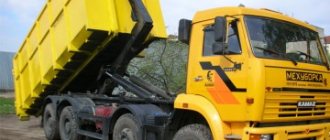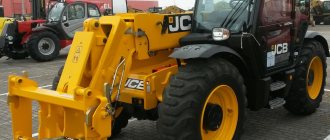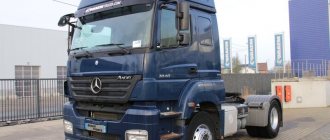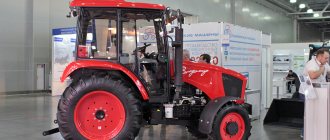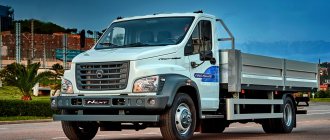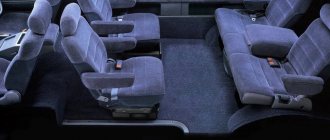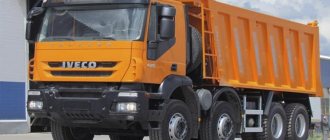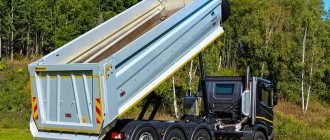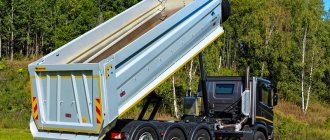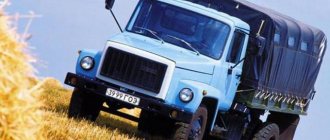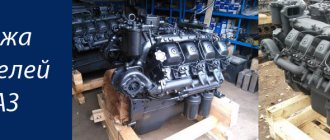Special vehicles equipped with a multi-lift system, due to their versatility, compare favorably with other types of freight vehicles. By purchasing a hook loader, the buyer receives several machines at once instead of one.
The design using the principle of interchangeable bodies allows you to transport almost any cargo on one vehicle: from household waste to containers or tanks, construction or agricultural equipment. “Multilifts” today simply have no competitors in meeting the needs of our rapidly developing world. They can significantly reduce the time of unloading and loading operations, increase the pace of cargo transportation and, importantly, save significant amounts. In addition, the use of the “multi-lift” system eliminates the cost of operating dump trucks, loaders and other equipment, plus eliminates possible downtime.
In the modern market there is a steady demand from buyers for “multi-lifts”. Having appeared in the late 1940s, this technique has long become a household name for a huge fleet of similar machines. Thus, the very word “multilift” - the general name for a loading and unloading system installed on a truck chassis, came to us along with the supply of Multilift brand lifts from Partek, which were produced in Finland. The inventors of such a system are the Terho brothers from Raisio (Finland), who in 1947 patented a superstructure for trucks that allows the on-board platform to be lowered to the ground. The truck lowered the hopper to the ground for loading, and transported the already loaded hoppers without downtime.
The equipment instantly became extremely popular, giving impetus to the further development of an entire direction in mechanical engineering. The company they founded, Multilift Oy, became part of the Partek company in 1977 and, after a long series of mergers, ended up as part of the well-known Swedish company HIAB, which has now become part of the Cargotec concern. It is worth noting that in the USSR a similar loading method was used much earlier: for example, in the Red Army, since 1932, as part of the N2P floating pontoon fleet, the ZiS “liter A-1” vehicle was used, transporting bow half-pontoons. The car had a sloping rear part of the cabin and a welded triangular metal truss with provisions for attaching a half-pontoon. To load the half-pontoons, a winch driven by the vehicle transmission was used.
From winch to multilift
The first multilifts appeared at the end of 1932 and were a winch with a movable frame and roller supports. These devices were used in the pontoon fleet of the Red Army to facilitate loading and unloading of prefabricated pontoon crossings.
Modern multilifts are equipped with high-quality hydraulics and special cargo cassettes. Due to its versatility, this device has found wide application in many industries, including utilities, cargo transportation, timber transportation and others.
Today, there are three types of multi-lifts, which are classified according to the type of lifting grip: cable, hook and frame grip.
This is interesting: Do-it-yourself xenon installation: instructions and diagram
Rent
Today, multilift rental is carried out, as a rule, by large companies whose specialization is the rental of road construction and other special equipment. Since in some branches of human activity multilift services are needed regularly, renting a multilift can often be carried out either on a long-term contractual basis or for a one-time event.
Along with other special equipment, the company offers multilift rental. This organization has a large fleet of special equipment, which allows the client to order a multi-lift as a small garbage truck.
Types of multilifts
Based on the design features of the grippers, there are three types of multilifts: cable, hook, and frame.
Cable
This type of equipment is the oldest. The operation of the mechanism is ensured by a winch mounted in the front part of the subframe.
The advantages of this design, in principle, come down to only one positive quality: the relatively small weight of the equipment itself.
There are significantly more disadvantages:
- the need to leave the cabin when carrying out loading and unloading operations;
- cases of broken or overlapping cables;
- speed limits during transportation;
- slow loading and unloading process.
Kryukova
This multilift is the most popular. If you compare this type of grip with a cable grip, everything here is exactly the opposite.
Pros:
- loading time is reduced;
- during loading operations the driver remains in the back;
- the body can be removed and used like a semi-trailer when passing through low tunnels;
- the module is securely fixed at 3 points using a hook and two clamps;
- permissible transportation speed is from 60 to 90 km/h.
Cons: the weight of the structure increases significantly.
Frame
This type of lift involves gripping the module from below. In principle, speaking about the advantages of such a machine, we can list all those that have been named regarding vehicles with a hook-type grip.
The disadvantages include the following:
- the vehicle’s approach to the module for loading must be extremely precise;
- the cost of the device itself is significantly higher than in other cases;
- the mechanisms are too susceptible to contamination, which limits the scope of use of these machines.
All loading and unloading mechanisms, such as hydraulic manipulators, multi-lifts and other equipment, will greatly facilitate the production and transportation process that construction and manufacturing enterprises face every day.
- Features of manual hoists
- ISSUES OF ECONOMICS AND LABOR SAFETY WHEN SELECTING AND OPERATING LOAD-LIFTING AND TRANSPORTING MACHINERY
- VBBShng-ls-1 5x25 coolant GOST
- Recommendations for choosing a business
- MSD construction equipment
- Heat pumps
Let's remember them by name...
Russian consumers are familiar with special equipment from European manufacturers of such brands as KROMANN, PALFINGER, Hiab, Hyva. PALFINGER multi-lifts are deservedly popular. The Austrian plant produces more than 50 models of hook loaders with a lifting capacity (g/c) from 5 to 32 tons. The Telescopic series of “multi-lifts”, which is most suitable for the requirements of the Russian market, is offered with a telescopic mechanism for moving the hopper. This design allows hook loaders to be used to handle containers of various lengths. In addition, loaders of this series can also be mounted on trailers. And easy access to all elements allows for quick and inexpensive scheduled maintenance. Like other Palfinger products, this series of loaders are characterized by ease of use, high safety standards, reliability and speed of operation. In addition, the Duo version, for example, of mod. Telescopic T07, suitable for containers with both small and large hook heights. The hook loader has a lifting capacity of 7 tons and, depending on the length of the “multi-lift,” is capable of working with containers with a length of 2700 to 5500 mm. Loading and unloading operations are controlled from an ergonomic remote control. A reinforced container bracket, hydraulic locks and a mechanical hook safety system ensure reliable movement and fixation of the load.
Considering that the cost of imported special equipment is not affordable for everyone, PALFINGER cooperates with many domestic enterprises, establishing production of its products in Russia. So, in 2014, PALFINGER, which includes the Russian one from Velikiye Luki, became part of the international concern PALFINGER. This machine-building plant offers budget options whose technical characteristics are at a high technical level. Founded in 1944, the company today produces 4 models of hook loaders of the MPR series with a capacity from 5 to 20 tons. MPR (Loading and Unloading Mechanism) is the proper name for an analogue of the “multilift” system.
Among the entire range of equipment, the mod stands out. MPR-20P.58, capable of easily handling a loaded 20-ton container, demonstrating loading time within 1.5 minutes. The MPR is manufactured using modern imported steels and hydraulic components from leading global manufacturers. It is designed for loading and unloading interchangeable bodies onto a vehicle; it will transport and install platforms, shift trucks, tanks and other structures.
In 2015, the company produced the first hook loader mod. PALFINGER PH T20 Pi capacity 20 tons. It is manufactured under license from the PALFINGER company and according to its original drawings, but entirely from domestic materials. Of the imported components, this model uses only hydraulic components: the main hydraulic distributor and hydraulic locks. This model of hook loader can be installed on domestic or imported three-axle chassis weighing 26 tons. Today, VELMASH-S is actively developing new market segments, so the plant plans to produce new models of loaders with a lifting capacity from 10 to 30 tons.
“Multilifts” of the KROMANN , have been successfully sold for many years by the official distributor Gruzavtomarket LLC . In addition to sales, the company organizes installation centers, warranty and service maintenance, thanks to which it has solid experience in the multi-lift market. Dozens of “multi-lift” projects of various load-carrying capacities have been developed on almost all available automobile chassis. Based on the technical specifications developed by the company, designers from Germany and Poland designed a basic line of KROMANN hooks specifically for the Russian market, characterized by increased load capacity, reliability and maintainability. The design of hook loaders uses the best experience of leading manufacturers of similar products, our own original design, technical solutions and know-how. The manufacturer of the KROMANN loader is the Polish partner of Skibicki Technika Transportowa with more than 35 years of experience in the production of superstructures for trucks. Due to such international work, as well as the favorable location of the Polish production site, the cost of the KROMANN “multilift”, with high European quality, is significantly lower than that of other well-known foreign brands.
Over the five years of operation in Russia, the range of loaders has expanded to 30 models, covering all market segments. These are mainly popular models in Russia with a retractable boom and hydraulic locking locks, made to the German container standard DIN-30722. There are different series of units to choose from: C4A - urban series (capacity 3–4 t), S5S - light series (capacity 5 t), MS7S - lightweight series (capacity 7 t), M12S, M14S - medium light series (leverage capacity 12–14 t), ML16S, ML18S – medium load capacity series (16–18 t), L22S – heavy series (leverage capacity 22 t), XL30S – extra heavy series (leverage capacity 30 T). Optionally, hook loaders can be manufactured to other standards: English - SHEM, Scandinavian - SS-3021. At the request of the customer, the hook loader can be adapted to several body standards. To do this, it has an additional hydraulic cylinder in the tower, which changes the height of the hook. All KROMANN models sold in Russia are adapted for operation in our weather conditions, both the overall service life and service intervals have been increased.
The most popular hook loader in Russia, KROMANN L22S.62.6, mounted on a 6x4 chassis, with a total weight of 33–38 tons, allows you to transport containers with cargo weighing up to 22 tons, length up to 7.0 m and volume up to 38 m3. Such indicators were achieved due to original technical solutions and the use of high-quality steels S355, Domex for load-bearing structures, Hardox for the hook, composite plastics with a service life of at least five years for guide plates, and reliable Italian hydraulics. Shot blasting of the surface, high-quality primer and painting provide a presentable appearance and reliable protection against corrosion. Rich basic equipment with a 4-section distributor, a 120-liter oil tank, remote and emergency control, and mounting plates for bolted mounting pleasantly distinguish this hook from its budget classmates. The optionally available functions of accelerated movement and smooth stop of the boom, variable tower height, rear stabilizing roller or rear spring lock allow this model to be positioned in the premium segment.
To summarize, we emphasize the main advantages of the “multilift” system. This is a quick unloading and loading or replacement of a replaceable module without the involvement of additional equipment. No vehicle downtime, including seasonal. The same vehicle, if equipped with replaceable modules, can perform various types of work during the working day without the need to re-equip the base machine. All operations are performed by one employee, who is both the driver of the vehicle and the operator during loading and unloading operations. Thus, the use of a “multilift” provides significant savings, because by purchasing one car, you get a car that performs the functions of an entire fleet of cars with stationary bodies and operates 24 hours a day.
Pros of using multilifts
Equipping this transport system has many advantages:
- reduction of material costs;
- solving difficulties with downtime due to the ability to quickly replace the cargo module;
- ensuring the safety of cargo movement;
- use of bodies for different purposes on one car;
- no need to involve auxiliary equipment.
The time required for loading or unloading is also reduced. The last type of work can be carried out in any suitable way: by dumping method or by lifting the body.
Loads for which the structure can be used
The multi-lift trailer allows you to move the following types of special cargo:
Multi-lift trailer in operation
- Containers for office and household type and mobile multifunctional centers.
- Tanks and wagons.
- Change houses and cargo containers.
- Solid waste bins.
- Platforms for large-sized mechanisms.
- Various agricultural bodies.
Most often, this system is used on trucks that are equipped with a chassis. Multilift installation can also be done on two-axle or three-axle trailers. For each system, depending on its dimensions and ability to lift containers, you can select a special vehicle with a suitable chassis.
This is interesting: MTZ-82 gear shift diagram and transmission device
Device
Structurally, the hook multi-lift system is an L-shaped frame, on the short arm of which there is a hook. With its help, a replacement body located on the ground or a trailer is grabbed by the eye located at its end end and dragged onto the vehicle.
KamAZ trucks with the multi-leaf system have several modifications:
- MPR-1 (MPR-14P.45). System with a lifting capacity of 14 tons with a fixed length frame and a rotating hook beam driven by a hydraulic cylinder and mounted on hinges.
- MPR-2 (MPR-18T.52). Unlike the previous one, the frame became telescopic, which made it possible to increase its length and use larger bodies. Load capacity – 18 tons.
- MPR-3 (MPR-20P.58). A 20-ton mechanism in which the frame is made folding.
Hyva manipulators use a telescopic frame. The company supplies its equipment for installation on a 4-axle KAMAZ chassis and has a load capacity of 26 tons.
Features of operation
This technique is in demand in various fields:
- Utilities. Suitable for transporting household waste, etc.
- Construction. Provides the ability to transport sand, gravel, crushed stone, a variety of special machinery and equipment (tractors, loaders, pumping units, power machines for increasing pressure, etc.), and with proper modification it can replace generators for supplying electrical energy.
- Road construction. Used for transporting polishing devices, sand and salt distributors, liquid reagent sprayers.
- Agriculture. It is used as a carrier of feed for livestock and for exporting grain crops after harvesting.
- Oil and gas industry. Carries out transit of cabin modules, tanks for process fluids and fuels and lubricants.
Multi-lift systems can be modified with auxiliary structures - grabs, buckets, which are designed for digging, and grippers used for loading or unloading work. This significantly expands the scope and functionality of the equipment: extraction and loading of bulk (lumpy, dusty, bulk) and piece cargo, activities for the destruction of landfills, etc.
back to news list view
Why is the demand for multilifts growing?
Attention to environmental problems leads to the closure of landfills that housed industrial and household waste. As a result, they are sent to landfills that meet the requirements of sanitary and epidemiological surveillance, waste incineration plants and processing plants.
And since new recycling sites are legally located 30–90 km from residential areas, waste trucks have to travel much longer distances than before.
But it is not profitable to deliver garbage using ordinary garbage trucks with a small carrying capacity to remote disposal sites. Therefore, garbage trucks collect solid waste in residential areas and unload it at intermediate waste transfer stations.
There, the waste is compacted, its volume is reduced, the waste in compact form is loaded into containers with a volume of 20 to 60 m3 and transported to landfills.
Therefore, now the most effective is the use of truck chassis technologies that work with interchangeable bodies - multilifts.
Trailers for KAMAZ garbage truck and Scania bunker truck
KAMAZ multi-lift trailers can be two, three or four axle. They are used for garbage trucks or bunker trucks as part of road trains to transport bulk or piece special cargo to waste processing plants or landfills. The following models are suitable for special vehicles based on KAMAZ or MAZ:
- Waste Systems PC21. The three-axle trailer will lift containers weighing up to 21,000 kg, produced in the Moscow region. The total weight of the structure is 26 thousand kilograms.
- VPM NefAZ-8560-10-06 12-02. Biaxial device from Velikoluksky metalworking enterprise. Load capacity is 13750 kg. The weight of the car is 20,000 kg.
- VPM NefAZ-8560-12-02. The second version of the trailer from the Velikoluksky manufacturer. The carrying capacity here is lower - 7600 kg, and the weight is 11.5 thousand kg.
For Scania bunker carriers, models from the St. Petersburg company Ecoprom are used. It provides models LVS 20, 29, 30 and 40. The Ecoprom Buggy option has the lowest weight and load capacity. A vehicle with Ecoprom SZAP can transport containers weighing up to 16,000 kg, and its weight is 21,000 kilograms.
Trailer LVS 20
